Big Red Social Media Channels
Subscribe to our YouTube channel: Big Red Media. Enjoy entertaining and informative videos with Big Red.
Latest News and Articles
How to Recover from Mistakes Doing a Big Car Repair at Home
How to Deal with Mistakes
Wrenching on your car would be all good if it weren’t for mistakes. The difference between a daily driver and a new addition to the salvage yard is your ability to recover from mistakes. It’s unlikely that you will never make a mistake, so if you are going to make major car repairs, you will be well served learning how to recover from mistakes. Common DIY mistakes can be broken down into two categories: parts problems and tool problems.
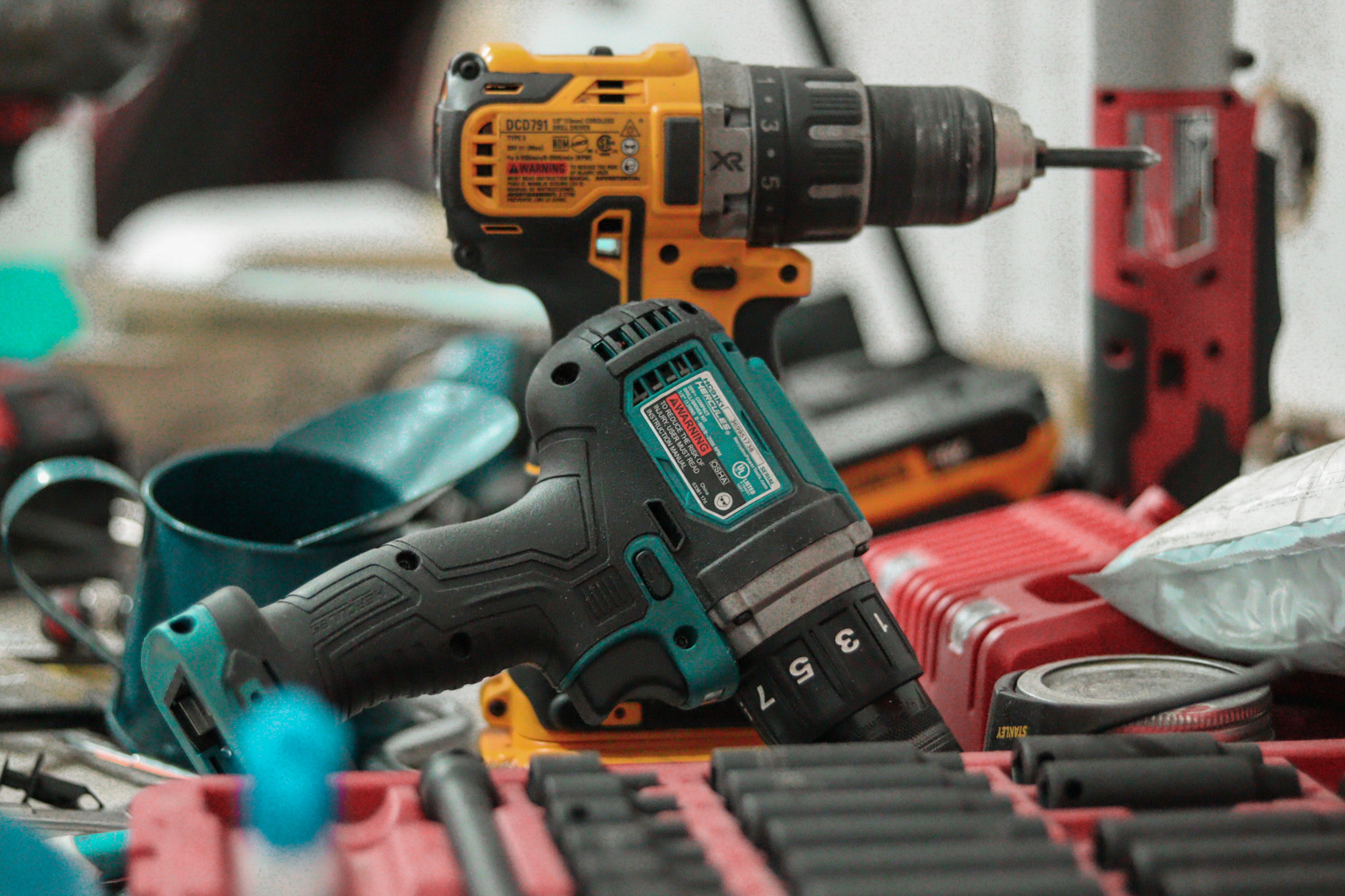
How to Find and Fix a Part
Parts problems can happen when a part breaks, when you must wait for replacement parts, or when you order the wrong part. They also involve finding the right part in the first place. For example, In our engine swap, we were working on a GM car that has been discontinued. We had to identify the similar car that they were still manufacturing. In our case, we found an identical substitute, and ordered parts accordingly. You might need to do some research to find the appropriate parts—ie., google. Breaking a part means carefully removing the broken part and then replacing it. This may also require special tools. YouTube is a good resource for fixing broken car parts. To replace your broken part, you can look for it locally, or order it online. Your repair may be delayed if you order your part online and must wait for it. What if you ordered the wrong part and then waited for it? Then you are held up twice as long. Carefully research the part you are replacing in order to avoid this issue. You also must take care when shopping locally to make sure you bring home the proper part.Which Tool is the Right for the Job?
Tool problems can either involve the wrong tool, or a tool breaking by itself.
There’s such a thing as an aftermarket tool and a recommended tool. There’s also such a thing as an inappropriate tool. Aftermarket tools may be appropriate in certain circumstances, but sometimes you need the recommended tool. Read the manual to see which you need in this circumstance. Our videos will give you the manual recommendations.
A truly inappropriate tool would be a screwdriver when you need a ratchet. A hammer doesn’t belong under the hood ever. But if the task calls for a rubber hammer, make sure you don’t grab the wrong kind by mistake.
If you are tightening a bolt incorrectly, you can break the bolt, or the tool. Is it because you are using a weak or cheap aftermarket tool, or is it because you didn’t read the spec’s properly in the manual? The manual can be the answer to both of these questions. See what tools and spec’s they recommend to solve your problem. What if you break a part by using the wrong tool? Then you must carefully remove and replace that broken part. None of these is a catastrophic problem.
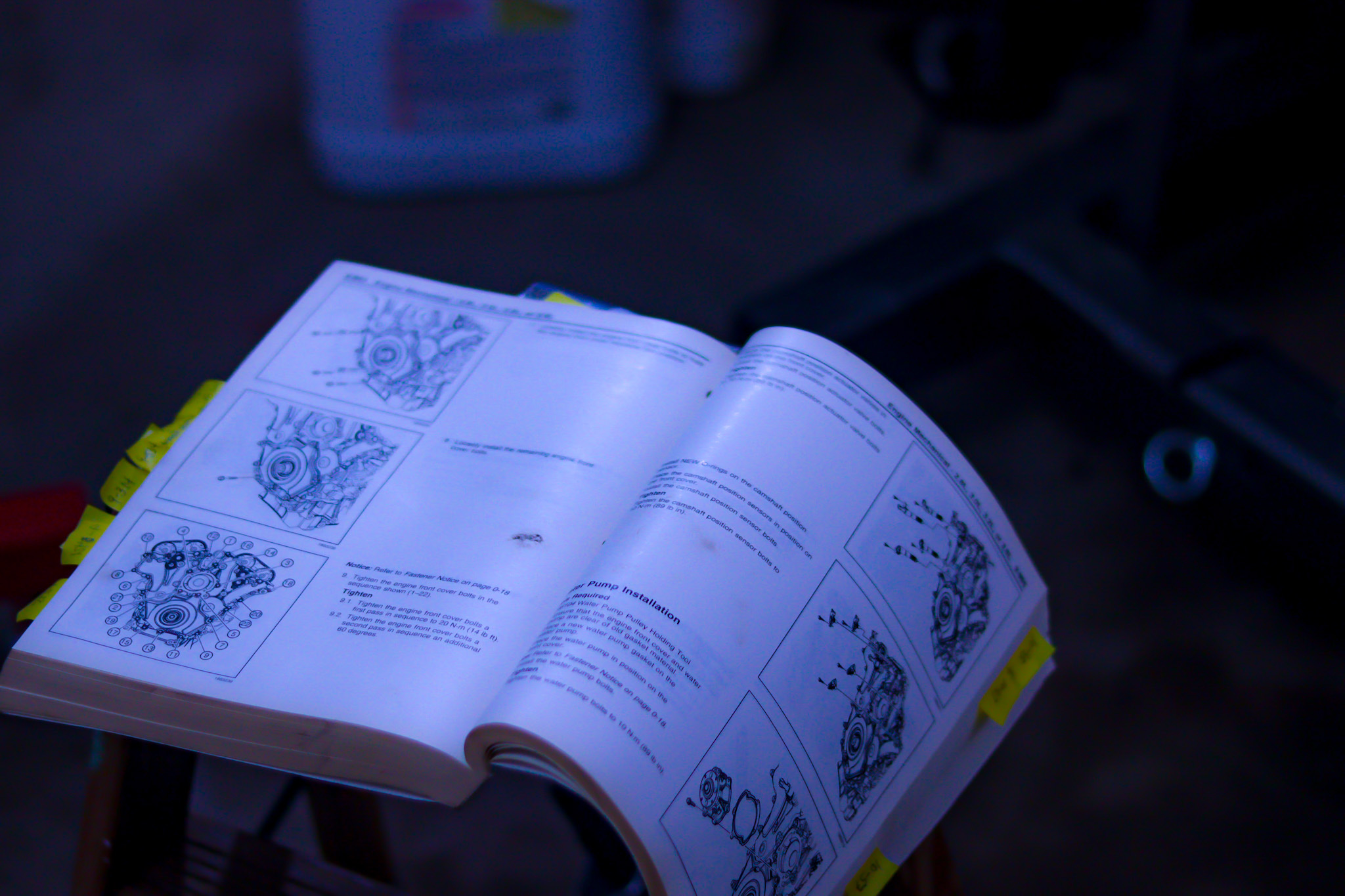
What About the Manual?
We’ve recommended consulting the manual a few times already. What if you don’t understand what the manual is saying? The Internet is a treasure trove of information. You can search for your problem until you understand what to do with your car.
If the manual gives conflicting directions, you can google your issue, and watch YouTube to get on the right track. You don’t want to learn that the hard way. Don’t let mistakes stop you from completing your goal.
There is Help
Recovering from mistakes is empowering when wrenching your car. Breaking mistakes into categories and then tackling them is a good approach.
We can help you through this process. We have completed an engine swap in our own garage. We taped the whole process in sparkling, indexed video. We used first and third person views, and you can choose which one would be more helpful to follow. You can order this video now.
Is $1500 a Good Deal on a Cheap Car?
One of life’s greatest inconveniences can be a lack of transportation. And, maybe you don’t want to take an Uber or buy a bus pass for every time you want to go somewhere. But, buying a new car is such a big investment. Say you’ve been saving for a car, and you have $1500 to spend. You ask yourself, “Should I buy a new or used car?” There is the Winter Beater, which we at Big Red call hoopties. These are 10 years or older, and have over 150,000 miles on them. Also commonly known as fixer-uppers or jalopies, these cars average about $1500, putting them on the low end of car prices, but they seem to be almost on their way out. The hooptie is not to be confused with what we will be calling a used car here, which would simply be a car that has been formerly registered in another person’s name. The fixer-upper isn’t as nice as the used car, but, there’s a way to coax a daily driver out of one.
Rankings of Each Car
So, now you’ve got three options: buy a beater car, buy a new car, or buy a used car. Where are you going to spend your $1500? How do you decide which kind of car to buy? We’re going to look at three things to consider when searching for the car for you: affordability, fixability, and reliability.
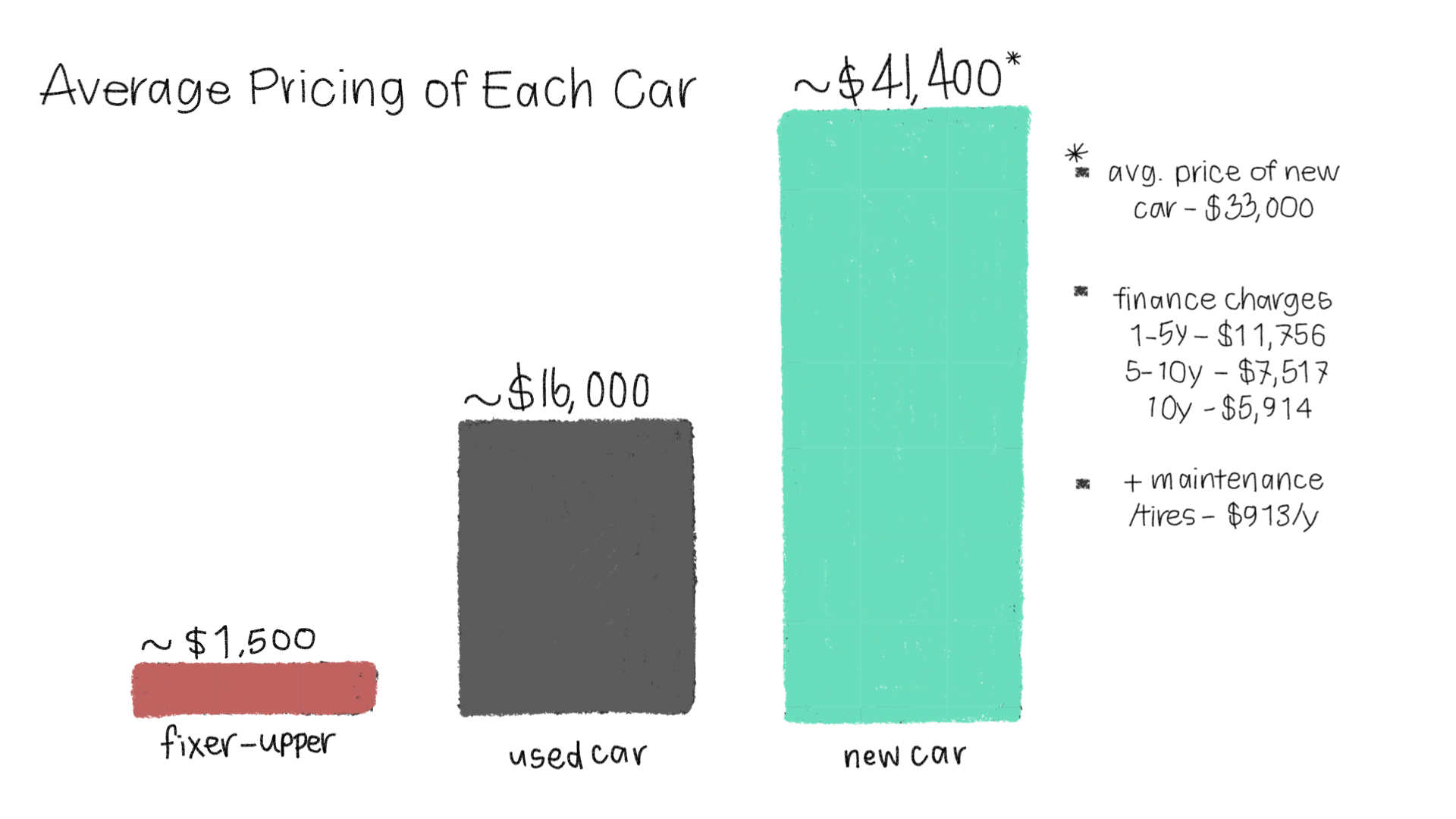
In the graph above, we show the various price averages of the three car options. From left to right, we feature the fixer-upper, the used car, and the new car. Included in the price of the new car: finance charges. We do not include maintenance in the price of any of the choices.
Pros of Buying a Fixer-Upper
Affordability
A fixer-upper car scores high on affordability and fixability. This is because it‘s cheap enough that you can buy it with cash; you won’t go into debt buying one. If you are in need of a car right now, this could be a good option for you. It can get you from point A to B, and also provide you with something to do, considering any repairs it would need to have done on it.
Fixability
If you enjoy car maintenance as a hobby, this could be a good car for you. And, if you keep your hooptie in good shape, it can be a vehicle you can rely on as well.
Cons of Buying a Fixer-Upper
Reliability
There are always downsides to each of these choices. While the hooptie is affordable and fixable, it cannot be relied upon to always work just the way you need it to, nearly as often as the new car or even the used car. You could find yourself staring down a bottomless pit of unknown repair fees, wondering when you should cut your losses and move on. Sometimes these cars just get too old. But again, if you keep this beater in good shape, the possibility of your car being this unreliable may not have to be a regular worry.
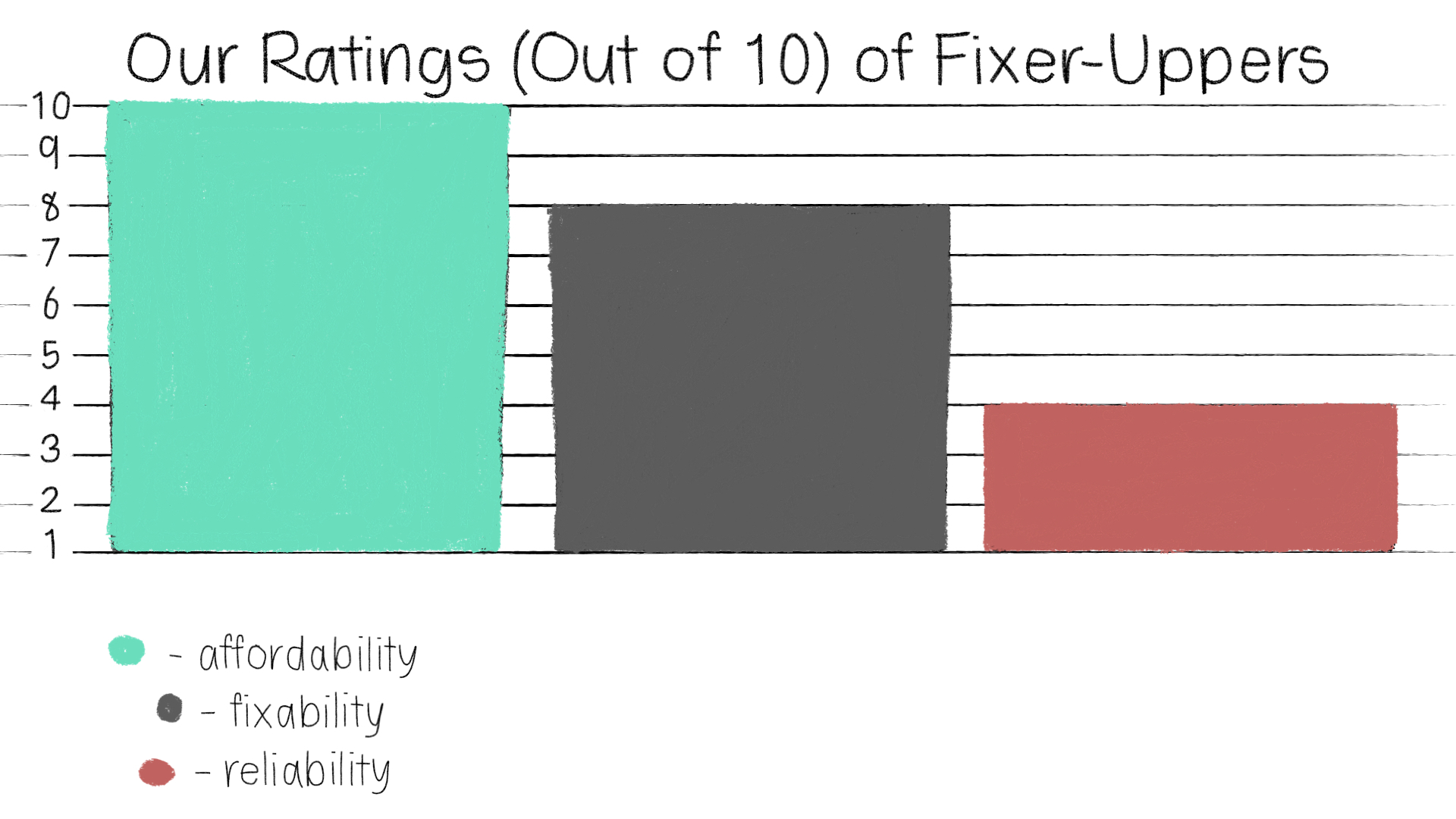
In the graph above, we rank fixer-upper cars in terms of affordability (teal), fixability, (gray), and reliability (red) on a scale of 1-10. 1 is least, 10 is most.
Pros of Buying a New Car
Reliability
If you decide to go with a new car, you can almost always depend on it for its reliability. This car has not been run down by years of use, and has never even been driven, except for the hopeful owners’ test drives. You know you can trust that this car will always start when you need it to, give you heat in the winter cold and A/C in the summer heat, and you know that it can, not only take you from point A to B, but also to C and D. You can spend your $1500 on a down-payment, and get a loan to cover the balance.
Cons of Buying a New Car
Affordability
Everyone resents the depreciation of value in a new car the minute they drive it off the lot. These cars are hardly affordable, and most people go into debt to buy one. This alone could be enough to turn one away from the idea, but there is another problem.
Fixability
These cars are not necessarily impossible to repair; but all of the extra features in these newer cars make for more and more things to be repaired if something breaks. However, when it is running, a new car is something you can rely on.
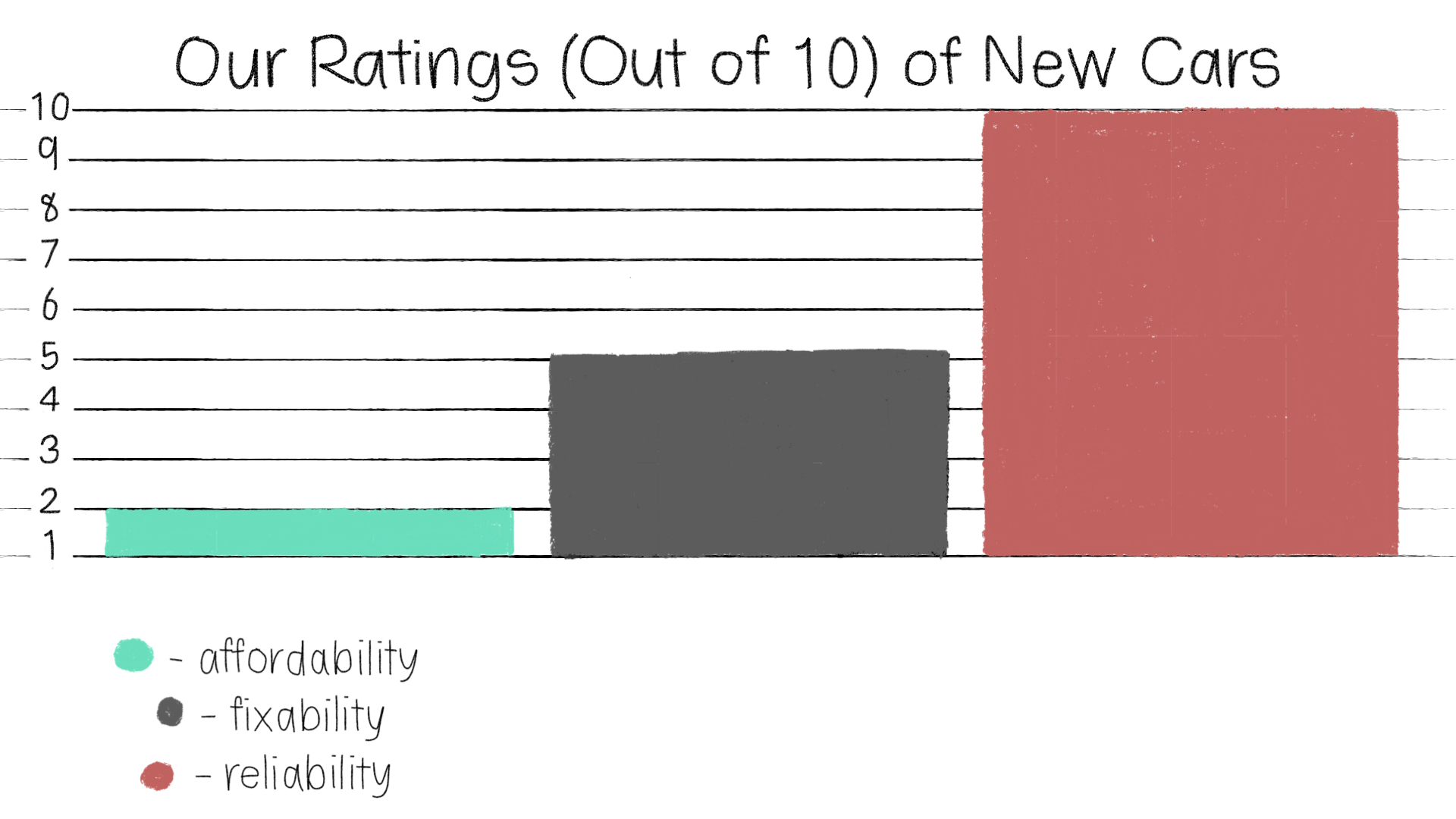
In the graph above, we rank new cars in terms of affordability (teal), fixability, (gray), and reliability (red) on a scale of 1-10. 1 is least, 10 is most.
Pros of Buying a Used Car
Affordability, Fixability, Reliability
The used car sits right in the middle, scoring higher than the fixer-upper in reliability, but still lower in affordability. You would need to spend the $1500 on a down payment and also get a loan for the balance, albeit a smaller loan than for a new car. The used car does combine all three of the criterion, but on a lower scale. You get average affordability, fixability, and reliability. But, if you are looking for something you can always rely on, without draining your bank account, the used car is a good option.
Cons of Buying a Used Car
Affordability, Fixability, Reliability
Since the used car is right in between the beater and the new car, and can have the pros of either one, it is reasonable to assume that it could also experience the cons of both. This car is more affordable than the new car, but much more expensive than that fixer-upper. It may be easier and/or less expensive to repair than a new car, but it may also experience problems that the beater would. Or, depending on the car, it could be a new one that had only been registered in someone else’s name first. In this case, the fixability would be a match to that of the new car.
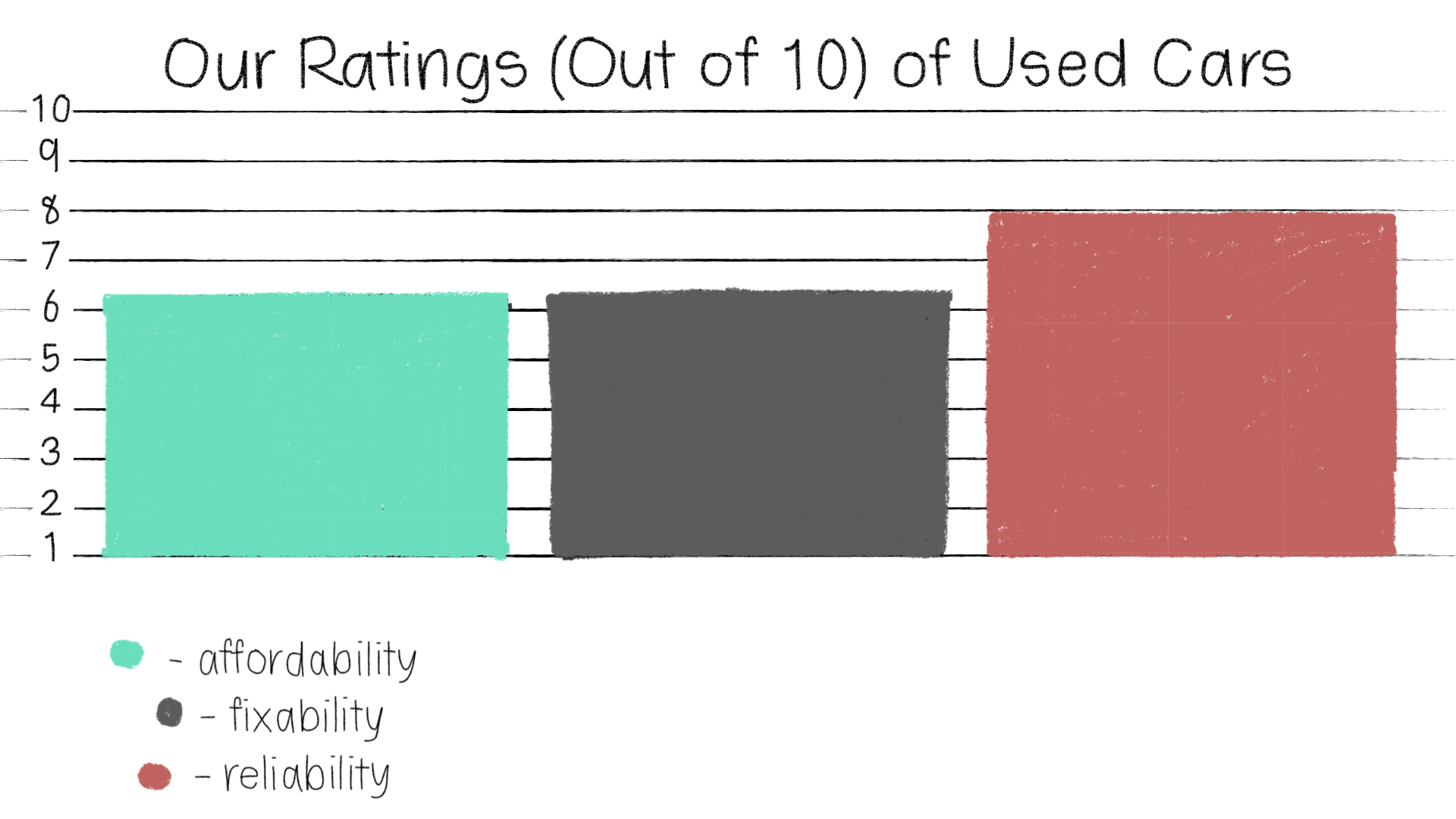
In the graph above, we rank used cars in terms of affordability (teal), fixability, (gray), and reliability (red) on a scale of 1-10. 1 is least, 10 is most.
Should I Buy a New or Used Car?
Now, you have three options. A hooptie, which is highly affordable and fixable, but not so reliable. There’s the new car, which is very reliable, but less affordable and fixable. And, finally, the used car, which is a little bit of all three. All three cars have their own compelling arguments. You should pay attention to them the next time you’re in need of a car. Buy new, or used? What will it be?
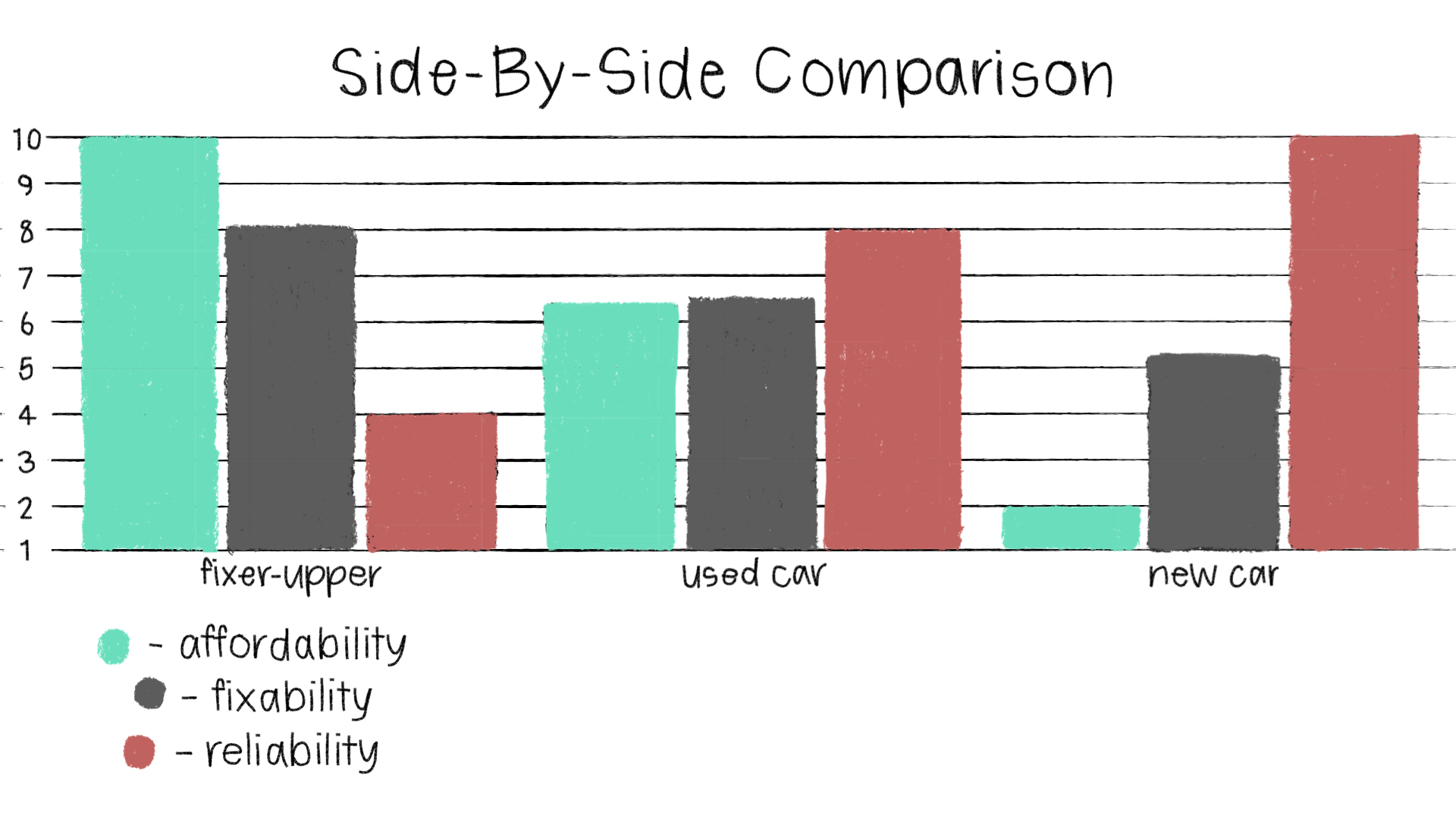
The graph above compares the rankings of all three cars in the terms above. They are ranked from 1-10, 1 being the least, and 10 the most.
First Start After 3.6L GM Engine Replacement
This video continues the story of oil priming. If you missed our definitive oil priming video, you should check it out. Visit our YouTube channel for more on our Tiny Two-Car Garage, Big Red, and the SUV.
Get Your Copy of the Engine Replacement Course!
Step by step instructions and high-definition videos walk you through the whole process of the engine removal and replacement. The entire comprehensive engine replacement course is available for order right now!
Signup For Updates and a FREE Gift
Signup for the Email List and get The Perfect Engine Swap Tools List, a complete list of the tools you’ll need to do an engine swap in your own garage. The List includes source links and current prices so you don't have to search around for the right tools.


